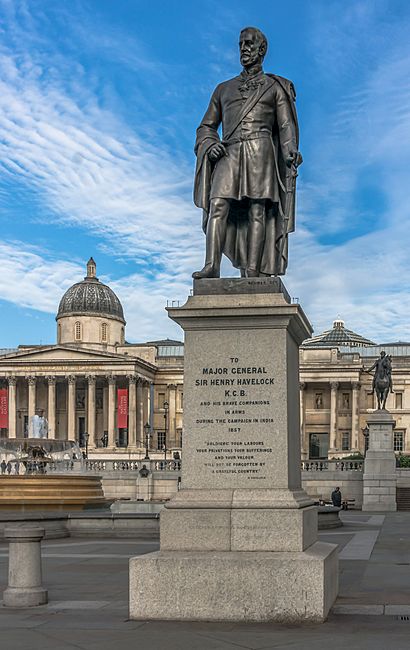Statue of Henry Havelock, Trafalgar Square facts for kids
Quick facts for kids Statue of Henry Havelock |
|
|---|---|

The statue in 2014
|
|
| Artist | William Behnes |
| Medium | Bronze sculpture |
| Subject | Henry Havelock |
| Location | London, United Kingdom |
| 51°30′28″N 0°07′39″W / 51.5079°N 0.1274°W | |
This bronze statue shows Henry Havelock, a famous British general. It stands in Trafalgar Square in London, United Kingdom. You can find it on one of the four stone bases, or plinths, in the square. It is located to the southeast of Nelson's Column.
About the Havelock Statue
The statue shows Major General Sir Henry Havelock in his military uniform. He is wearing a cloak. The statue is made of bronze, a type of metal.
Henry Havelock was born in 1795. He passed away in 1857. He was a soldier for many years. He fought in wars like the First Anglo-Burmese War in the 1820s. He also served in the First Anglo-Afghan War in the 1840s.
In 1857, he helped regain control of cities like Kanpur and Lucknow. This happened during a big uprising in India. He died shortly after this from an illness called dysentery.
Building the Statue
People say this statue was one of the first made using a photograph. This was a new idea at the time. The public helped pay for the statue. Many people donated money to have it built.
It was put up in 1861. It stands on a strong granite base. This base looks similar to the one for General Charles James Napier's statue. That statue was put up nearby in 1855–1856. Another copy of Havelock's statue is in Mowbray Park in Sunderland. People also paid for that one. It was also shown to the public in 1861.
The Statue's Place in History
In 1936, some people thought about changing the statues in Trafalgar Square. They suggested replacing Havelock's statue and Napier's statue. They wanted to put up statues of Admirals Beatty and Jellicoe. These admirals were important naval leaders. They fought in the Battle of Jutland in 1916.
However, the statues of the Victorian generals stayed. Instead, bronze busts of the admirals were placed against the north wall of the square. Later, a bust of Admiral Cunningham was also added there.
In 1970, the statue became a Grade II listed building. This means it is an important historical structure. Trafalgar Square itself is even more important. It is a Grade I listed site.
In 2000, the Mayor of London, Ken Livingstone, talked about the statues. He suggested removing the statues of Havelock and General Charles James Napier. He said he didn't know who they were.

